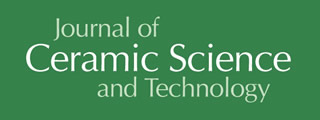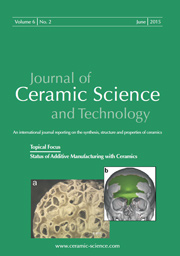Articles
All articles | Recent articles
Synthesis of LaCrO3 and La0.9Ca0.1CrO3 by Modified Glycine Nitrate Process
A. Bonet, N. Travitzky, P. Greil
University of Erlangen-Nuremberg, Department of Materials Science (Glass and Ceramics), Martensstr. 5, D-91058 Erlangen, Germany
received October 11, 2013, received in revised form December 1, 2013, accepted March 11, 2014
Vol. 5, No. 2, Pages 93-100 DOI: 10.4416/JCST2013-00024
Abstract
LaCrO3 and La0.9Ca0.1CrO3 ceramics were synthesized in the modified glycine nitrate process (MGNP). The effect of the equivalence ratio Φe of precursor mixtures on the combustion reaction was investigated by means of DSC and TG-FTIR analyses. It was found that for Φe > 0.65 the combustion reaction proceeds in a self-propagating one-step process, resulting in the formation of well-crystallized single-phase powders. Further glycine addition (Φe < 0.65) leads to sluggish multi-step combustion, which is typical for fuel-rich combustion, and the formation of secondary phases such as La2CrO6. Furthermore it could be found that the ignition temperature of the precursors rises with rising fuel content. An influence of the equivalence ratio on the specific surface area and particle size of synthesized powders could not be detected. The specific surface area of the powders was in the range of 5 – 10 m2/g and particle size 100 – 150 nm.
![]() Download Full Article (PDF)
Download Full Article (PDF)
Keywords
Lanthanum chromite, modified glycine nitrate process, combustion synthesis
References
1 Hashimoto, T., Takagi, K., Tsuda, K., Tanaka, M., Yoshida, K., Tagawa, H., Dokiya, M.: Determination of the space group of LaCrO3 by convergent-beam electron diffraction, J. Electrochem. Soc., 147, 4408 – 4410, (2000).
2 Minh, N.Q.: Ceramic fuel cells, J. Am. Ceram. Soc., 76, 563 – 588, (1993).
3 Fergus, J.W.: Lanthanum chromite-based materials for solid oxide fuel cell interconnects, Solid State Ionics, 171, 1 – 15, (2004).
4 Zhu, W.Z., Deevi, S.C.: Development of interconnect materials for solid oxide fuel cells, Mater. Sci. Eng., A348, 227 – 243, (2003).
5 Wakisaka, K., Kado, H., Yoshikado, S.: Fabrication and evaluation of ca, Sr-doped-LaCrO3 thin film electric heaters, Key Eng. Mat., 269, 121 – 124, (2004).
6 Suvorov, S., Zuev, A., Pozniak, I., Pechenkov, A., Shatunov, A., Kydryash, M., Niemann, B., Nacke, B.: Functional materials on the base of lanthanum chromite. In: Proceedings of the Third International Forum on Strategic Technologies IFOST 2008. Novosibirsk-Tomsk, 2008.
7 Andrianov, M.A., Balkevich, V.L., Sotnikov, V.E.: Use of lanthanum chromite for making electric heaters, Refract. Ind. Ceram., 21, 592 – 596, (1980).
8 Meadowcroft, D.B., Meier, P.G., Warren, A.C.: Hot ceramic electrodes for open-cycle MHD power generation, Energ. Convers., 12, 145 – 147, (1972).
9 Yokokawa, H., Sakai, N., Kawada, T., Dokiya, M.: Chemical thermodynamic considerations in sintering of LaCrO3-based perovskites, J. Electrochem. Soc., 138, 1018 – 1027, (1991).
10 Groupp, L., Anderson, H.U.: Densification of La1-xSrxCrO3, J. Am. Ceram. Soc., 59, 9 – 10, (1976).
11 Duvigneaud, P.H., Pilate, P., Cambier, F.: Factors affecting the sintering and the electrical properties of sr-doped LaCrO3, , 14, 359 – 367, (1994).
12 Sakai, N., Kawada, T., Yokokawa, H., Dokiya, M., Kojima, I.: Liquid-Phase-assisted sintering of calcium-doped lanthanum chromites, J. Am. Ceram. Soc., 76, 609 – 616, (1993).
13 Mori, M., Yamamoto, T., Ichikawa, T., Takeda, Y.: Dense sintered conditions and sintering mechanisms for alkaline earth metal (Mg, ca and Sr)-doped LaCrO3 perovskites under reducing atmosphere, Solid State Ionics, 148, 93 – 101, (2002).
14 Carter, J.D., Nasrallah, M.M., Anderson, H.U.: Liquid phase behavior in nonstoichiometric calcium-doped lanthanum chromites, J. Mater. Sci., 31, 157 – 163, (1996).
15 Simner, S.P., Hardy, J.S., Stevenson, J.W., Armstrong, T.R.: Sintering of lanthanum chromite using strontium vanadate, Solid State Ionics, 128, 53 – 63, (2000).
16 Chick, L.A., Pederson, L.R., Maupin, G.D., Bates, J.L., Thomas, L.E., Exarhos, G.J.: Glycine-nitrate combustion synthesis of oxide ceramic powders, Mater. Lett., 10, 6 – 12, (1990).
17 Purohit, R.D., Sharma, B.P., Pillai, K.T., Tyagi, A.K.: Ultrafine ceria powders via glycine-nitrate combustion, Mater. Res. Bull., 36, 2711 – 2721, (2001).
18 Toniolo, J.C., Lima, M.D., Takimi, A.S., Bergmann, C.P.: Synthesis of alumina powders by the glycine-nitrate combustion process, Mater. Res. Bull., 40, 561 – 571, (2005).
19 Bošković, S.B., Djurović, D.R., Zec, S.P., Matovic, B.Z., Zinkevich, F., Aldinger, F.: Doped and Co-doped CeO2: preparation and properties, Ceram. Int., 34, 2001 – 2006, (2008).
20 Bošković, S.B., Matovic, B.Z., Vlajić, M.D., Kristić, V.D.: Modified glycine nitrate procedure (MGNP) for the synthesis of SOFC nanopowders, Ceram. Int., 33, 98 – 93, (2007).
21 Liu, X., Su, W., Lu, Z.: Study on synthesis of Pr1-xCaxCrO3 and their electrical properties, Mater. Chem. Phys., 82, 327 – 330, (2003).
22 Kikukawa, N., Takemori, M., Nagano, Y., Sugasawa, M., Kobayashi, S.: Synthesis and magnetic properties of nanostructured spinel ferrites using a glycine-nitrate process, , 284, 206 – 214, (2004).
23 Valefi, M., Falamaki, C., Ebadzadeh, T.: New insights of the glycine-nitrate process for the synthesis of nano-crystalline 8YSZ, J. Am. Ceram. Soc., 90, 2008 – 2014, (2007).
24 Vijayan, L., Cheruku, R., Govinadaraj, G., Rajagopan, S.: Physical and electrical properties of combustion synthesized NASICON type Na3Cr2(PO4)3 crystallites: effect of glycine molar ratios, Mater. Chem. Phys., 130, 862 – 869, (2011).
25 Zhuravlev, V.D., Vasil'ev, V.G., Vladimirova, E.V., Shevchenko, V.G., Grigorov, I.V., Bamburov, V.G., Beketov, A.R., Baranov, M.V.: Glycine-nitrate combustion synthesis of finely dispersed alumina, Glass Phys. Chem., 36, 506 – 512, (2010).
26 Jain, S.R., Adiga, K.C., Verneker, V.R.P.: A new approach to thermochemical calculations of condensed fuel-oxidizer mixtures, Combust. Flame, 40, 71 – 79, (1981).
27 Nair, S.R., Purohit, R.D., Tyagi, A.K., Shina, P.K., Sharma, B.P.: Role of glycine-to-nitrate ratio in influencing the powder characteristics of La(Ca)CrO3, Mater. Res. Bull., 43, 1573 – 1582, (2008).
28 Shao, Z., Zhou, W., Uhu, Z.: Advanced synthesis of materials for intermediate-temperature solid oxide fuel cells, Prog. Mater. Sci., 57, 804 – 874, (2012).
29 Chick, L.A., Liu, J., Stevenson, J.W., Armstrong, T.R., McCready, D.E., Maupin, G.D., Coffey, G.W., Coyle, C.A.: Phase transitions and transient liquid-phase sintering in calcium-substituted lanthanum chromite, J. Am. Ceram. Soc., 80, 2109 – 2120, (1997).
30 Ianculescu, A., Braileanu, A., Pasuk, I., Zaharescu, M.: Phase formation study of alkaline earth-doped lanthanum chromites, J. Therm. Anal. Calorim., 66, 501 – 507, (2001).
31 Zupan, K., Pejovnik, S., Maček, J.: Synthesis of nanometer crystalline lanthanum chromite powders by the citrate-nitrate autoignition reaction, Acta Chim. Slov., 48, 137 – 145, (2001).
32 Nair, S.R., Purohit, R.D., Sinha, P.K., Tyagi, A.K.: Sr-doped LaCoO3 through acetate-nitrate combustion: Effect of extra oxidant NH4NO3, J. Alloy. and Compd., 477, 644 – 647, (2009).
33 Biamino, S., Badini, C.: Combustion synthesis of lanthanum chromite starting from water solutions: Investigation of process mechanism by DTA-TGA-MS, J. Eur. Ceram. Soc., 24, 3021 – 3034, (2004).
34 Fagerlund, G.: Determination of specific surface by the BET method, Mat̩riaux et Construction, 6, 239 Р245, (1973).
Copyright
Göller Verlag GmbH


